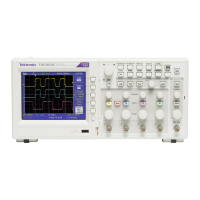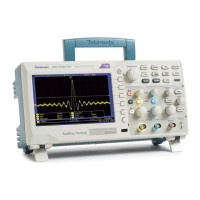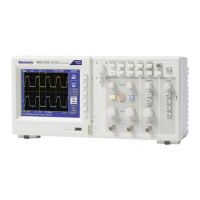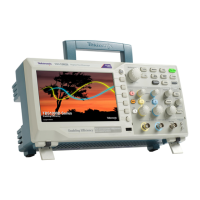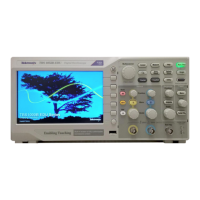Equal guardband t > 330 ns: ±5% < guardband < ±(5.1% + 16.5 ns)
t ≤ 330 ns: guardband = ±16.5 ns.
All pulses, even from the most stable sources, have some
amount of jitter. To avoid disqualifying pulses that are intended to
qualify but are not absolutely correct values, Tektronix provides
an arbitrary guardband. Any measured pulse width within the
guardband will qualify. If you are looking for pulse width
differences that are smaller than the guardband width, offsetting
the center should allow discriminating differences down to the
guardband accuracy.
Not equal guardband 330 ns < 1: ±5% ≤ guardband < ±(5.1% + 16.5 ns)
165 ns < 1 < 330 ns: guardband = -16.5 ns/+33 ns
t ≤ 165 ns: guardband = ±16.5 ns
All pulses, even from the most stable sources, have some
amount of jitter. To avoid disqualifying pulses that are intended to
qualify but are not absolutely correct values, Tektronix provides
an arbitrary guardband. Any measured pulse width outside the
guardband will qualify. If you are looking for pulse width
differences that are smaller than the guardband width, offsetting
the center should allow discriminating differences down to the
guardband accuracy. Not equal has slightly better ability to deal
with small pulse widths than equal. The accuracy is not better.
Pulse-Width trigger point Equal: The oscilloscope triggers when the trailing edge of the
pulse crosses the trigger level.
Not Equal: If the pulse is narrower than the specified width, the
trigger point is the trailing edge. Otherwise, the oscilloscope
triggers when a pulse continues longer than the time specified as
the Pulse Width.
Less than: The trigger point is the trailing edge.
Greater than (also called the time out trigger): The
oscilloscope triggers when a pulse continues longer than the time
specified as the Pulse Width.
Triggering system (cont.) Specifications
TBS1000C Series Specification and Performance Verification 9
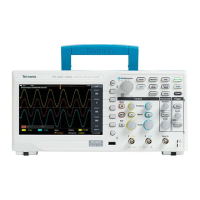
